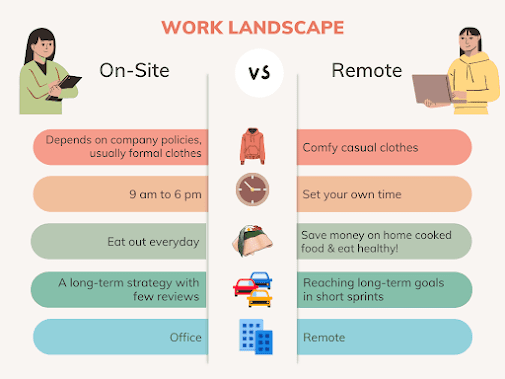Following the global outbreak of COVID-19, remote and hybrid work arrangements have become increasingly significant in the field of human resource management (HRM). These flexible work arrangements not only satisfy the changing needs of the workforce but also significantly increase employee satisfaction. Let's examine how remote and hybrid working patterns are transforming HRM processes.
To begin with, employees who operate remotely or in a hybrid setting report feeling more in control and enjoying a better work-life balance. HRM professionals enable employees to work from home or choose a combination of office-based and remote work arrangements, allowing them to better manage their personal and professional duties. This flexibility promotes a happy workplace, which lowers burnout and raises job satisfaction.
Additionally, remote and hybrid working methods eliminate geographical restrictions, opening up new opportunities for talent acquisition and retention. HRM departments may ensure a workforce that is inclusive and diverse by leveraging an international talent pool that is not limited by geographic location. These arrangements also promote equity and diversity in the workplace by accommodating people who have caregiving duties or impairments.
Additionally, remote and hybrid work arrangements help firms and employees save money. Financial gains are evident when travel costs, office overhead, and operational efficiency are reduced. HRM specialists can reallocate funds to wellness initiatives, staff development projects, and other benefits, which will improve overall job satisfaction and organizational performance.
Furthermore, technology is essential to the creation of hybrid and remote work settings. To enable smooth remote work operations, HRM departments make use of cutting-edge communication systems, project management software, and collaboration tools. Organizations may improve employee happiness and productivity by ensuring that workers can perform their duties effectively from any location by investing in a strong IT infrastructure and offering sufficient training and support.
In conclusion, there are several benefits associated with remote and hybrid work arrangements that raise employee satisfaction and signal a paradigm shift in HRM practices. By adopting technology advancements, flexibility, and inclusivity, organizations may create work environments that are fit for the diverse demands of their workforce. In the end, this will result in success in the digital era.
image source - ADP Research Institute
Conclusion
In summary, remote and hybrid work environments provide employees more flexibility, inclusion, and a work-life balance, making them a revolutionary approach in HRM. These approaches improve operational efficiency, talent acquisition, cost savings, and work satisfaction all at the same time. Encouraging a flexible mindset and embracing technology are essential to maximizing the benefits of remote and hybrid work environments. Organizations may prosper in a changing environment and maintain competitiveness in the modern workplace by putting employee well-being first and utilizing cutting-edge HRM methods.
References
1. "Remote Work Statistics: Navigating the New Normal" - Buffer. Retrieved from: https://buffer.com/state-of-remote-work
2. "The State of Remote Work 2021" - Owl Labs. Retrieved from: https://www.owllabs.com/state-of-remote-work
3. "How Hybrid Work Helps Employees Thrive" - Harvard Business Review. Retrieved from: https://hbr.org/2022/01/how-hybrid-work-helps-employees-thrive
4. "Remote Work: The New Normal and Its Impact on Employee Satisfaction" - SHRM. Retrieved from: https://www.shrm.org/resourcesandtools/hr-topics/employee-relations/pages/remote-work-employee-satisfaction.aspx
5. "The Benefits of Remote Work: Advantages Beyond Flexibility" - FlexJobs. Retrieved from: https://www.flexjobs.com/employer-blog/remote-work-benefits/







Making a flexible work environment will lead to better mange personal and professional responsibilities. Through this employee satisfaction is enhanced and it wil lead to perform well in the organization.
ReplyDeleteGood article
ReplyDeleteemployee satisfaction is amust to have a good work environment
ReplyDelete
ReplyDeleteInsightful perspective on remote and hybrid work's impact on HRM. Well-articulated benefits for both employees and organizations.
satisfied employees decide the success of a business.
ReplyDeleteThis post talks about how remote and hybrid working arrangements are changing Human Resource Management after COVID-19. It says these arrangements make employees happier by giving them more flexibility. They also help companies save money and find talent from all over the world. HRM specialists use technology to make remote work easier and invest in things that make employees happier. Overall, remote and hybrid working are new ways HRM is helping employees and companies succeed.
ReplyDeleteA crucial topic when it comes to work life, balance, and employees, satisfaction, and retention. Good structure and well organized good research
ReplyDeleteYou focus on technology as an essential tool for supporting remote and hybrid working models. The use of technology-enabled communication channels can help organizations ensure that remote workers feel included, engaged, and valued as part of the team.
ReplyDeleteIn today's dynamic work landscape, where remote and hybrid working models have become increasingly prevalent, it's paramount for organizations to prioritize employee satisfaction. From a Human Resource Management (HRM) perspective, nurturing a positive work environment that supports remote and hybrid arrangements is key to enhancing employee satisfaction and overall organizational success.
ReplyDeleteemployee satisfaction is most important to buildup good working enviroment
ReplyDelete